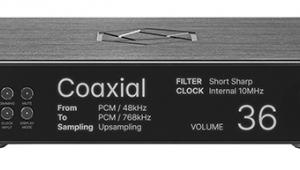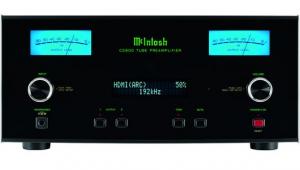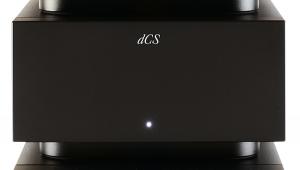Chord Qbd76hd (£4110)
It doesn’t seem that long ago since D-to-A converters featuring USB sockets were something quite rare. How times have changed in just a few short years. Today pretty much all standalone DACs – including models from UK specialist manufacturer Chord Electronics – have them. Computer audio is ubiquitous in modern households, after all. But not all USB interfaces are made equal, standard off-the-shelf solutions being limited to 16-bit/48kHz audio and incapable of handling hi-res 24-bit audio files at 96 or 192kHz sampling frequencies. Chord’s DACs, even its luxurious models, have been lagging behind the high-end competition in this respect. So enter this brand new QBD76HD model, the ‘HD’ in the nomenclature signifying the inclusion of a high definition/hi-res-capable USB input that is fully 24/192 compatible.
BLUETOOTH DROPPED
The QBD76HD isn’t an entirely new design from Chord. Under the skin it is in fact the highly acclaimed QBD76 model that the company introduced some three years or so ago, featuring its fifth generation Pulse Array DAC and sophisticated WTA filtering. Utterly bespoke in nature, the QBD’s digital input reception, digital filtering/upsampling and D/A conversion is achieved using custom software running on a powerful FPGA.
Dedicated followers of hi-fi fashion will recall Chord’s introduction of its diminutive Chordette Gem a few years ago, its first DAC to feature a Bluetooth (A2DP) wireless receiver. Chord’s high-end QBD76 (which remains in the company’s product line at £3600) includes this Bluetooth receiver too. For this brand new ‘HD’ version of its QBD76, however, Chord has removed it and replaced the receiver with its new USB interface. And – yes, of course – like all the latest USB inputs that have appeared in recent times in other manufacturers’ DACs designed for high resolution audio replay, it’s an asynchronous type whereby the DAC itself controls the flow of data from the host computer in order to minimise jitter.
It doesn’t require a vivid imagination to envisage the brain-storming meetings that will have been going on in Chord Electronics’ offices in rural Kent. It goes without saying that anyone in the market for a luxurious high-end DAC costing circa £4k will be precisely the sort of enthusiast who’s relishing the increasing availability of hi-res ‘studio master’ file downloads from specialist record labels – the best of which make the humble 16-bit/44.1kHz compact disc sound so last century. Connection from a computer source to a 24/192-capable outboard DAC doesn’t have to be via USB, of course, but for the majority it is the most straightforward method of connection when simply pushing audio from a PC or Mac – particularly from laptops.
So, then, as pretty much all high-end DACs these days feature hi-res-capable USB inputs, Chord has clearly felt the need to join the throng for fear that potential purchasers might pass its QBD76 by – despite its S/PDIF and twin AES/EBU inputs already being perfectly up to hi-res tasks provided they are connected to an appropriately equipped soundcard.
It’s a well-timed move from the company, I’m sure. Its revision of the QBD76 to transform it into a QBD76HD is expedient. Where the Bluetooth antenna screwed into the rear of the DAC’s enclosure is fitted the new ‘USB2’ HD input.
Unfortunately, for cable fetishists keen to experiment with various USB cables, it’s on a proprietary (LEMO-style) circular connecting socket. Chord supplies its own 480Mbit/s-capable cable fitted with the appropriate plug at one end and an A-type USB plug at the other. Explained Chord’s production manager Matthew Bartlett, ‘It would have been a very expensive modification to mill out a square hole at the rear of the QBD76’s thick aluminium casework to accommodate a B-type USB socket. And it does mean we can ensure consistency of performance in supplying our own USB cable, eliminating any possibility of someone inadvertently using an old USB 1.0 spec cable [12Mbit/s] and experiencing problems.’
RETROFIT POSSIBLE
Existing owners of the QBD76 hungry to join the brave new world of audiophile computer audio – and willing to forgo their Bluetooth wireless functionality – can talk to their local Chord dealer about a retrofit. You’ll need to budget around £600 or so for the modification. New asynchronous USB input aside, the QBD76HD remains as before. There are five inputs: USB1 (standard-res), USB2 (hi-res), coaxial S/PDIF (BNC), optical S/PDIF (Toslink) and AES/EBU (XLR) – the last three each having two input sockets provided. And as you’d expect at the price, the QBD76HD has both single-ended and balanced analogue outputs.Three countersunk chromed ball-bearing type push buttons facilitate scrolling through the fi ve inputs, selecting between positive and negative absolute phase, and operating the DAC’s on-board RAM buffer (off, minimum or maximum buffering). I found the buffering improved the sound markedly, sharpening the image and increasing clarity, so left it engaged to ‘Max’ for listening to music. The four seconds delay this creates takes a while to become accustomed to – and buffering needed to be disabled when routing the sound from this year’s HDTV broadcasts from Glastonbury through my hi-fi system!
While the large magnifying glass window on the top is merely for gawking at the DAC’s innards, the smaller window provides status readout of settings – and, importantly, a data stream’s incoming sampling rate – via a dot matrix display buried inside.
If you’re looking to substantially upgrade the sound of an aged CD player to bring it up to modern day audiophile standards, the QBD76HD will certainly breathe new life into your music collection. Its clarity and detail resolution are revelatory.
FORENSIC DETAIL
Familiar CD tracks sounded freshly polished via the QBD76HD. I used Primare’s CD32 player as a disc transport, making use of its AES/EBU balanced digital output. As a standalone CD player the Primare is pretty fabulous in its own right, sounding tremendously clear and vivid. Ahem, trebling the price of my CD source by adding the Chord took CD replay from being really very good indeed to absolutely stellar. It reminded me of the pleasure I had living with Chord’s cost-no-object Red Reference MkII CD player for a few weeks. The sound of this DAC is incredibly clean and vivid, with immensely powerful bass that is breathtaking given appropriate recordings.Its high frequencies are smooth and extended too, percussion ringing truthfully, full of sparkle and life.
On David Sylvian’s ‘River Man’ from Gone To Earth [Virgin CDVDL 1] percussionist Steve Jansen’s hypnotic drums and sampled bass were mesmerising, the track’s sinister ambience heightened by the dynamic wallops of chunky bass that remained fully descriptive of timing and texture despite gargantuan proportions. Robert Fripp’s achingly beautiful ‘treated’ guitar embellishments can be difficult to follow in the piece with so many ambient effects muddying the recording’s production, but the QBD76HD separates everything out so clearly that analysis of each layer of detail becomes less challenging – and infectiously engaging too.
‘Analytical’ and ‘explicit’ are adjectives that might imply cold, stark, matter-of-factness in describing the way a component delivers a musical message. But recalling the forgiving nature of the Red Reference player I spun up the merciless Stadium Arcadium album by the Red Hot Chili Peppers [Warner Bros 49996-2] for the first time in ages, an appalling example of CD’s insane volume wars. Sure enough, the DAC’s power of resolution kept the Chili’s hard, brittle edges and spitting high frequencies under reasonable control, making the album’s 100-mile-an-hour thrashings surprisingly listenable, where lesser quality CD replay might have you running for your listening room’s nearest exit.
The Chord is analytical, but proves forgiving in equal measure.I was highly enamoured of North Star’s Essensio DAC reviewed in our July issue. Changing from one fabulous DAC to another, comparing varying degrees of digital excellence in succession, showed that the differences were not as chalk and cheese. And because it costs only £825 I’m bound to observe that the Essensio is defi nitely worthy of a ‘budget esoterica’ mantle, delivering as it does a delicious taste of high-end digital at almost one-fifth of the price of the QBD76HD. But the Chord is better. It removes a further layer of veiling and its detailed, controlled bass information is highly addictive in a wide bandwidth system.
Given the QBD76HD’s obviously thoroughbred DNA, I was therefore choked to discover that I was unable to assess properly the capability of its new hi-res USB input. I can report that it works seamlessly. After loading the supplied bespoke driver software (a straightforward set-up procedure when attaching the DAC to a computer for the first time) I was playing out hi-res successfully using Foobar2000 in a matter of a couple of minutes. Whatever I selected from my library of hi-res downloads the QBD76HD’s USB2 input locked successfully on to the data, and the display window indicated the correct sampling frequency of each source file.
RIPS REVEALED
But as our Lab Report clearly suggests, there was something seemingly not quite right with our review sample. Roll off the very highest frequencies by 1 or 2dB and a DAC might sound ‘smooth’. When its response is fully 10dB down at 20kHz it sounds as if your speakers’ tweeters have been covered with a cloth. Everything that I played sounded warm and cuddly and, er, noticeably dull. What a pity! Clearly this is something Chord will investigate, to ensure it hasn’t been shipping units like this to its dealers. If unfortunately it has, then fingers crossed it’s simply an issue with the driver software that can be rectified easily ‘in the field’.
I can also report that the QBD76HD’s ‘legacy’ USB input sounds extremely good playing regular, CD quality audio files, especially with the RAM buffer engaged to Max. Clearly it has been well implemented, as it proved to be highly transparent to source recordings. I know that when listening to the digitally synthetic pure pop of ‘Left To My Own Devices’ from the Pet Shop Boys’ Introspective album it’s impossible to know what it should really sound like. Nonetheless I was able to hear marked differences when I compared two WAV files of the song ripped from both an original 1988 CD release [Parlophone CDP 7 90868 2] and a Japanese issue on EMI [CP25-5670]. The Japanese version sounded more clearly focused and detailed, with cleaner high frequencies and less blurred bass information.
If you observed such a difference when A/B-ing two CD players or DACs you’d proclaim, ‘Wow, what an upgrade in sound quality!’ Here I wasn’t changing my set-up in any way, simply comparing two different releases of the same album. That the QBD76HD highlighted such variation even through its standard USB interface speaks volumes about its resolving capabilities.
VERDICT
Sound from CD doesn’t come much better and Chord’s DAC is commended on this basis alone. It provides a forensic inspection of detail alongside dynamic shading and tonal purity that sounds simply ‘right’. The ‘hewn from solid’ build is equally fabulous although some will consider its styling too ostentatious. I look forward to hearing what the QBD76HD can deliver with hi-res recordings over USB.
Originally published in the September 2011 issue


























































